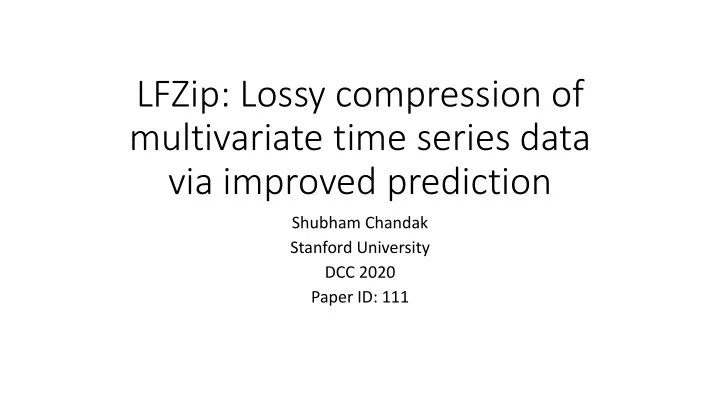

LFZip: Lossy compression of multivariate time series data via improved prediction Shubham Chandak Stanford University DCC 2020 Paper ID: 111
Joint work with • Kedar Tatwawadi, Stanford • Tsachy Weissman, Stanford • Chengtao Wen, Siemens • Max Wang, Siemens • Juan Aparicio, Siemens
Outline • Motivation • Problem formulation and our contribution • Previous work • Methods • Results • Conclusions and future work
Motivation • Sensors are omnipresent: generating vast amounts of data • Data usually in form of real-valued time series Nanopore genome sequencing Figure credit: https://directorsblog.nih.gov/2018/02/06/sequencing-human-genome-with-pocket-sized-nanopore-device/ https://semielectronics.com/sensors-lifeblood-internet-things/
Motivation • Floating-point time series data typically noisy • Lossy compression can lead to vast gains without affecting performance of downstream applications • Multivariate time series • Different variables can have correlations • Compression performed on computationally constrained devices • Low CPU and memory usage (streaming compression)
Problem formulation compressed 𝑦 ! , $ $ 𝑦 " , … , $ 𝑦 # 𝑦 ! , 𝑦 " , … , 𝑦 # Compress Decompress bitstream 32-bit floats !×# Compression ratio = $%&' () *(+,-'..'/ 0%1.-'2+ %# 031'. Error constraint: max %45,…,# 𝑦 % − & 𝑦 % ≤ 𝜗 Maximum absolute error
Our contribution • LFZip: Lossy compressor for time series data • Works with user-specified maximum absolute error • Multivariate time series compression • Based on prediction-quantization-entropy coder framework • Normalized Least Mean Squares (NLMS) prediction • Neural Network prediction • Significant improvement for a variety of datasets • Open source: https://github.com/shubhamchandak94/LFZip
Previous work • Swinging door and critical aperture • retain a subset of the points in the time series based on the maximum error constraint and use linear interpolation during decompression • SZ, ISABELA, NUMARCK • polynomial/linear regression model followed by quantization • SZ current state-of-the-art - Bristol, E. H. "Swinging door trending: Adaptive trend recording?." ISA National Conf. Proc., 1990 . 1990. - Williams, George Edward. "Critical aperture convergence filtering and systems and methods thereof." U.S. Patent No. 7,076,402. 11 Jul. 2006. - Liang, Xin, et al. "An efficient transformation scheme for lossy data compression with point-wise relative error bound." 2018 IEEE International Conference on Cluster Computing (CLUSTER) . IEEE, 2018. - Lakshminarasimhan, Sriram, et al. "ISABELA for effective in situ compression of scientific data." Concurrency and Computation: Practice and Experience 25.4 (2013): 524-540. - Chen, Zhengzhang, et al. "NUMARCK: machine learning algorithm for resiliency and checkpointing." SC'14: Proceedings of the International Conference for High Performance Computing, Networking, Storage and Analysis . IEEE, 2014.
Encoder architecture
Decoder architecture
Predictor • Predict based on past window (default 32 steps) • NLMS (normalized least mean square) • Adaptively trained (gradient descent) after every step • Multivariate: predict based on past values for all variables
Predictor • Predict based on past window (default 32 steps) • NLMS (normalized least mean square) • Adaptively trained (gradient descent) after every step • Multivariate: predict based on past values for all variables • NN (neural network) • Offline training performed on separate dataset • We tested fully connected (FC) and RNN models (results shown for FC) • To simulate quantization error during training, we add random noise
Quantizer and entropy coder 16-bit uniform quantization , Δ 1 = 𝑦 1 − 𝑧 1 Δ 1 𝑦 1 & ⊕ with step-size Prediction error 2𝜗 𝑧 1 • If prediction error above 2 !$ 𝜗 , set $ 𝑦 % = 𝑦 %
Quantizer and entropy coder 16-bit uniform quantization , Δ 1 = 𝑦 1 − 𝑧 1 Δ 1 𝑦 1 & ⊕ with step-size Prediction error 2𝜗 𝑧 1 • If prediction error above 2 !$ 𝜗 , set $ 𝑦 % = 𝑦 % • Entropy coding: BSC (https://github.com/IlyaGrebnov/libbsc) • High performance compressor based on BWT
Results: datasets
Results: datasets
Results: datasets
Results: univariate (NLMS prediction)
Results: univariate (NLMS prediction) LFZip performs better LFZip performs worse
Results: univariate (NN prediction)
Results: multivariate (NLMS prediction)
Results: computation • LFZip (NLMS): ~2M timesteps/s for univariate • Slower than SZ but practical for most applications • LFZip (NN): ~1K timesteps/s for the fully connected model used • Run single-threaded on a CPU to allow reproducibility • Requires further optimizations for practical usage
Conclusions and future work • LFZip: error-bounded lossy compressor for multivariate floating-point time series • Based on prediction-quantization-entropy coder framework • Achieve improved compression using NLMS and NN models
Conclusions and future work • LFZip: error-bounded lossy compressor for multivariate floating-point time series • Based on prediction-quantization-entropy coder framework • Achieve improved compression using NLMS and NN models • Future work includes • optimized implementation for the neural network based framework • extension of the framework to multidimensional datasets • exploration of other predictive models to further boost compression
Thank You! Check out https://github.com/shubhamchandak94/LFZip
Recommend
More recommend